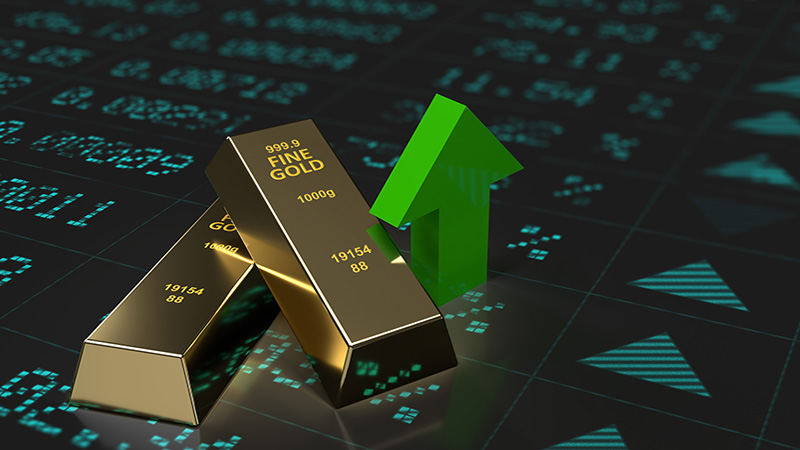By Tom Roderick, manager of the Trium Epynt Macro fund
Gold is potentially on the cusp of a major bull market – but what is driving the yellow metal’s upward trajectory?
The value of gold often traces out a path dictated by US real rates. There is no yield on it, so when real rates are high, investors want to funnel money into the economy and out of gold to benefit from these high returns.
But when real rates are low, investors seek haven in gold, seeing value in its elemental defence against human progress.
However, gold has ceased to follow real rates since early 2022. As the Fed pushed real rates higher, gold ought to have struggled. While gold did not rally, it did hold its value in the face of real rates moving quickly through zero and up above 2%.
In late 2023, as the pace of the real rates increase slowed, gold continued to rally substantially.
Official buying steps up
This change has been driven by an increase in central bank accumulation. Buying scaled up significantly as Trump imposed tariffs on China in 2017, then further following the breakout of Russia’s war in Ukraine in early 2022. This seems to be the key geopolitical juncture for a shift in the behaviour of the gold price.
Europe joined the US and the rest of the developed world in putting sanctions on Russian banks and freezing their overseas assets. The move sent shockwaves throughout the world as countries that were not aligned with the US feared their assets would be similarly confiscated or frozen.
See also: Gold hits record high: Fund picks to play precious metals
Despite the significant accumulation of gold by non-aligned banks, the amount of gold held is still small relative to the West. This means pushing up the gold price reflates Western balance sheets more. Non-aligned countries need to be subtle in their buying; it is not in their interest to drive the price up quickly. So why are they buying in such force?
There are two answers to this question. The first is that China is weak. The second is that China is lying.
China forced to accumulate gold
China accumulating more gold does not herald the demise of the US dollar, US hegemony or power. It points to weakness rather than strength.
A redistribution of economic power would break the Chinese state and so will only happen in the case of an economic collapse. Hence, the surpluses will continue. Where to invest these surpluses is fast becoming a major problem for China.
The lack of liquid financial assets outside the West leads China towards outbound Foreign Direct Investment (FDI). This means doing business in jurisdictions that lack political stability and have weak legal systems that are vulnerable to politics and can’t or won’t enforce contract law.
As the West has discovered, even with the full might of the international institutions behind them, claims tend to fall secondary to local politics. China found this in its first iteration of the One Belt One Road scheme. Many investments have been overbudget, unfinished or abandoned.
Gold is a frustrating asset to accumulate as it is less liquid and useful than US treasuries and leads to higher volatility in the end goods you want to hold your purchasing power against. It is only when you consider gold accumulation as an option versus expropriation risk, or a 50-cent return on FDI, that China’s policy starts to make more sense.
Not enough bullion
There also isn’t enough gold. The current account surplus of China alone is equivalent to the entirety of global gold production at today’s prices.
Of course, China isn’t the only buyer. The bull case for gold does not rely on China recycling the proceeds from selling down its current Western bond holdings; not wanting to add to existing expropriation risk is enough, and there is not much else to buy.
Gold is a murky market with clear data only extending to what is mined rather than who owns what. Partly, this is because those attracted to gold want to evade attention for one reason or another. That said, there is enough information to put together a rough picture.
See also: ARC: Positive gold sentiment not reflected in portfolio weightings
We have a fair idea of how much central banks have been buying in aggregate, as these purchases tend to be done in the West and using dollars. These purchases are considered “monetary gold” for use as recognised reserve assets by central banks, accepted by credit rating agencies and international institutions like the IMF.
Buyers through this route are easy to track in aggregate as they tend to be significant orders in much larger bar sizes than other investors. China’s official sector likely holds significantly more gold than is officially reported. Its central bank seems to follow the international rules for reserve accumulation but often declares its holdings with a large delay.
China’s buying spree
In the last couple of years, the buying pace by central banks has doubled but the increase in the sum of all gold reserves claimed has stayed around the same level. History (and market chatter) tells us that of the 1,250 tonnes of undeclared gold purchases over the past two years, the vast majority is China. That would mean its true reserves are closer to 3,000 tonnes rather than their stated reserves of 1,750 tonnes.
This is still only half the story. All locally produced or ‘privately’ imported gold in China goes through the Shanghai Gold Exchange. Net imports of gold into China have been around 24,000 tonnes since the exchange was established in 2008. This is large compared to central bank reserves, even if you think the true reserve number is understated.
We estimate that China’s true state holdings of gold are the world’s largest. That means non-aligned countries are not far behind the volumes of gold held by the West. As it reaches parity with the West, China’s desire to purchase gold in the shadows could come into the light more quickly than the market expects.










